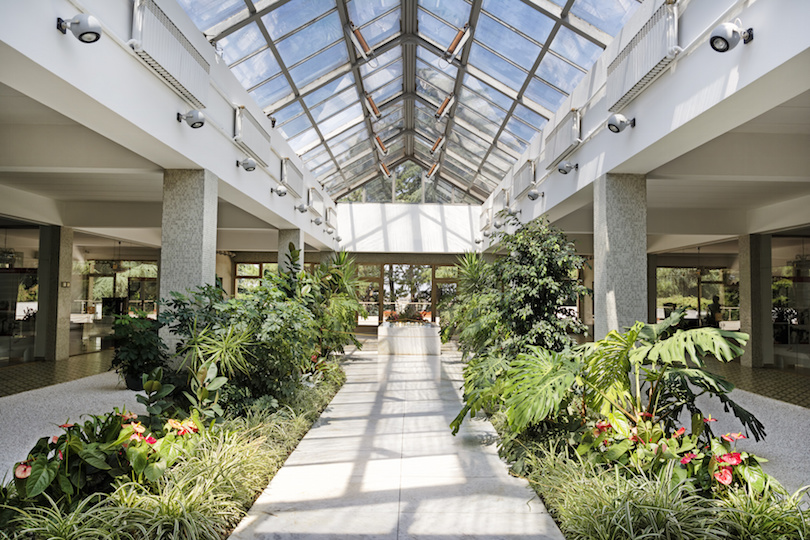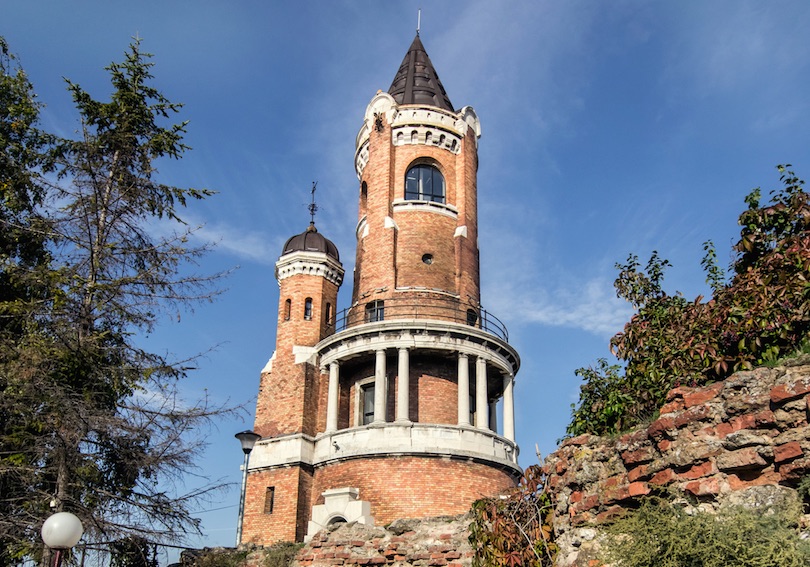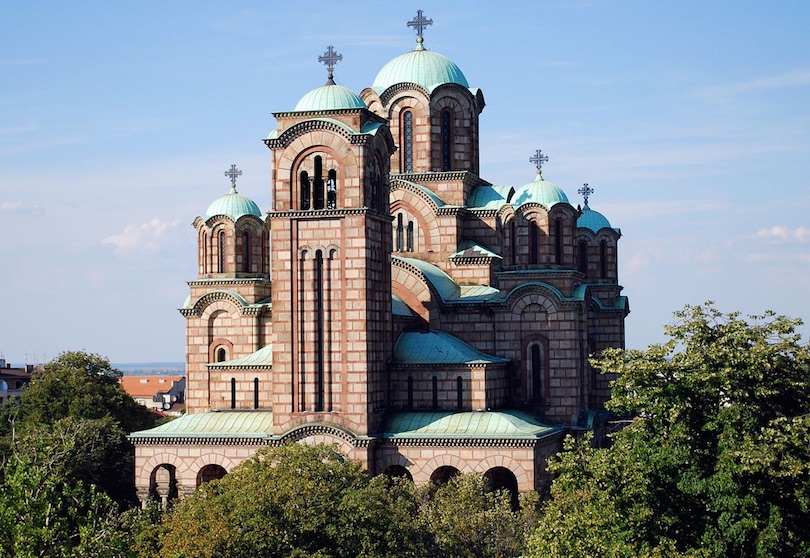With its turbulent, war-torn past, Belgrade is like a phoenix rising from the ashes to become one of today’s hottest European capitals. Belgrade, home to two million people, is a pretty city sitting at the confluence of the Danube and Sava rivers. You’ll want to walk along the river banks, perhaps stopping for a drink or meal at a riverboat that’s been converted to a restaurant before visiting the attractions in Belgrade. The Serbian capital is fast becoming known as a center for international festivals; hosting more than 100 a year, for sure there will be one going on whenever you visit.
10. Avala Tower
The Avala Tower, built in 1965 and destroyed by NATO bombing of Serbia in 1999, was rebuilt in 2010, becoming the tallest telecommunications tower in the Balkans. The original tower, with an observation deck, was a source of pride for the region. Public donations paid for the tower’s rebuilding. It can be found on Avala Mountain on the outskirts of Belgrade. At 206 meters (675 feet) high, it is the fifth tallest structure in Serbia; you can literally see for miles and miles from the observation deck.
9. House of Flowers
Josip Broz Tito led the Yugoslav Partisans in World War II, later going on to become president of Yugoslavia. A respected leader in the international stage, he died in 1980; he and his wife are burred at the House of Flowers, also known as Tito’s Mausoleum. For a while, flowers surrounded his tomb, giving rise to the name House of Flowers; the flowers are gone now, replaced by white rocks. It was built in 1975 as a winter garden for Tito, who chose to be buried here. The mausoleum today is part of the Museum of Yugoslav History.
8. Gardos Tower
The Gardos Tower is but a youngster when compared to ancient or medieval monuments; it was constructed in 1896. But it’s just as impressive as anything built centuries earlier. It’s also known as the Millennium Tower or the Tower of Janos Hunyadin, a Hungarian hero who died more than 400 years ago on the site of an earlier fortress. Some ruins from the earlier fortress remain today. Originally one of five towers built by the Hungarians to celebrate 1,000 years of rule in the region, the landmark is located in Zemun, 20 km (13 miles) from Belgrade.
7. Nikola Tesla Museum
Well over a century ago, Nikola Tesla energized electricity, inventing the AC system, the electric coil and related items. Generations later, these inventions would lead to a car named after him, the Tesla electric car. They also led to a museum dedicated to his work in central Belgrade. The Nikola Tesla Museum contains thousands of documents, books, photographs and drawings related to his work of electrifying the world. The museum also houses interactive exhibitions including computerized models of his inventions.
6. Crkva Svetog Marka
Crkva Svetog Marka, or Cathedral of St. Mark, was basically completed in 1940 on the site of a wooden church dating back to 1835. Located in central Belgrade’s Tašmajdan park neighborhood, it is one of the largest churches in the country; not too far away is Parliament building. . Above the outside entrance to the church, you’ll find a mosaic of the Apostle Mark for whom the church is named. The church is filled with centuries old icons; several rulers are buried in the crypt.
5. Knez Mihailova Street
Every city has one: a street that oozes charm, is lined with historic buildings and is where shoppers snap up bargains. In Belgrade, this street is Knez Mihailova Street, named after a Serbian prince. Less than a mile long, the street dates back to the Ottoman days, though it never really came into its own until the 19th century when the wealthy started building homes here. Historic buildings along its path include Srpska Kruna Hotel, built in 1869; private homes at 46, 48 and 50 Knez Mihailova, that date from the 1870s, and Greca Kraljica, a coffee shop in an 1835 building.
4. Temple of Saint Sava
With a 134-meter (440-foot) high dome, the Temple of Saint Sava dominates Belgrade’s skyline. To make it even taller, the dome is topped with a gold cross almost 12 meter (40 feet) high. The largest Orthodox church in use today, it is dedicated to Saint Sava, an important medieval personage who founded the Serbian Orthodox church. It is located on the Viacar Plateau, where Saint Sava is thought to be buried. Construction on the white marble and granite church started in 1935, halted during World War II and resumed in 1985. Though it is still under construction today it is already one of the most popular attractions in Belgrade.
3. Ada Ciganlija
Ada Ciganlija is an island cum artificial peninsula in the Sava River/Lake that runs through central Belgrade. With its pretty beaches and sports facilities, Ada draws upwards of 100,000 visitors a day during the summer. Nicknamed “Belgrade’s Sea,” Ada’s peninsula is filled with thick forests that resemble a wilderness area, so you might see deer, rabbits and fox. Houseboats, a weekend retreat for Belgrade residents, can be found at the northern end. Ada Ciganlija is an athlete’s dream with dozens of sports facilities ranging from tennis to rugby to rowing, with artificial facilities for alpine skiing and snowboarding.
2. Skadarlija Street
Skadarlija Street may not be very long, just 400 meters (1,340 feet), but it’s the most famous street in Belgrade. Located in the Old Town, it connects Despot Stefan Boulevard with Dusanova Street. The street is lined with vintage buildings. With a bohemian atmosphere, Skadarlija Street is considered Belgrade’s version of Montmartre in Paris. In fact, it was known as the Gypsy quarter in the 19th century. It’s a place where poets gather for Skadarlija Evenings at the house of the late poet Dura Jaksic, and where the Children’s Street Theatre performs circus acts. The restaurants and outdoor cafes welcome diners, including celebrities, from all over.
1. Belgrade Fortress
Because of its strategic defensive location, people have lived at the confluence of the Sava and Danube rivers since Neolithic times. Then the invaders moved in, first the Celts and later the Romans, who built a palisade here, followed by the Huns and the Goths. It was a Serbian leader, however, in the 15th century who really beefed up the fortifications here. The fortress is remarkably intact, occupying a large chunk of the area. Besides the fortifications, the official fortress area includes a church, a museum and several popular parks.
/div>



 The Gardos Tower is but a youngster when compared to ancient or medieval monuments; it was constructed in 1896. But it’s just as impressive as anything built centuries earlier. It’s also known as the Millennium Tower or the Tower of Janos Hunyadin, a Hungarian hero who died more than 400 years ago on the site of an earlier fortress. Some ruins from the earlier fortress remain today. Originally one of five towers built by the Hungarians to celebrate 1,000 years of rule in the region, the landmark is located in Zemun, 20 km (13 miles) from Belgrade.
The Gardos Tower is but a youngster when compared to ancient or medieval monuments; it was constructed in 1896. But it’s just as impressive as anything built centuries earlier. It’s also known as the Millennium Tower or the Tower of Janos Hunyadin, a Hungarian hero who died more than 400 years ago on the site of an earlier fortress. Some ruins from the earlier fortress remain today. Originally one of five towers built by the Hungarians to celebrate 1,000 years of rule in the region, the landmark is located in Zemun, 20 km (13 miles) from Belgrade.






























